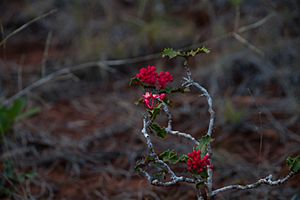Casearia crassinervis facts for kids
Quick facts for kids Casearia crassinervis |
|
|---|---|
 |
|
| Conservation status | |
| Scientific classification | |
| Genus: |
Casearia
|
| Species: |
crassinervis
|
Casearia crassinervis is a special kind of flowering plant that belongs to the Salicaceae family. This family includes plants like willows and poplars. Casearia crassinervis is a unique species found only in one place: the beautiful island of Cuba. When a plant or animal is found only in one specific area, we call it endemic. This makes Casearia crassinervis very important to Cuba's natural world.
Scientists have studied this plant and found that it is currently considered a vulnerable species. This means it faces a high risk of becoming endangered or even disappearing forever if we don't protect it.
Contents
What is Casearia crassinervis?
Casearia crassinervis is a type of plant that produces flowers. It's part of the Casearia genus, which includes many different species of shrubs and small trees found in tropical and subtropical regions around the world. While we don't have many specific details about its appearance, most Casearia plants are known for their simple leaves and small, often greenish or yellowish flowers.
Where does it live?
This particular plant, Casearia crassinervis, is found only on the island of Cuba. Cuba is the largest island in the Caribbean Sea and is famous for its rich and diverse plant and animal life. Many species, like Casearia crassinervis, are endemic to Cuba, meaning they can't be found naturally anywhere else on Earth. This makes Cuba a very important place for biodiversity.
The specific habitats where Casearia crassinervis grows are usually tropical forests or woodlands. These areas provide the right climate and soil conditions for the plant to thrive.
Why is it vulnerable?
The main reason Casearia crassinervis is listed as vulnerable is often due to habitat loss. This happens when the places where plants and animals live are destroyed or changed by human activities. For example, forests might be cut down for farming, building, or other developments.
What does "vulnerable" mean?
The term "vulnerable" is used by an organization called the International Union for Conservation of Nature (IUCN). The IUCN creates a "Red List" that tells us which species are at risk of extinction. When a species is listed as vulnerable, it means:
- Its population has decreased a lot.
- Its habitat is shrinking.
- It faces threats that could make its situation worse.
Protecting vulnerable species like Casearia crassinervis is very important. It helps keep our planet's ecosystems healthy and balanced. Conservation efforts often involve protecting their natural habitats, planting new trees, and raising awareness about their importance.
See also
 In Spanish: Casearia crassinervis para niños
In Spanish: Casearia crassinervis para niños


